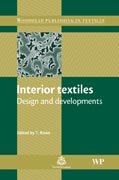
This book provides an overview of the types of textiles used within the interior textile sector and key technological developments and safety issues affecting the industry. An understanding of these topics enables the designer or manufacturer to select the most appropriate fabrics for interior applications. The first group of chapters reviews types and selection of materials for interior textiles, including natural and synthetic fibres as well as knitted, woven and nonwoven fabrics. Further chapters review surface design of interior textiles and the use of textiles in carpets and floor coverings. The second part ofthe book discuses developments in such areas as joining furniture fabrics, the use of sustainable and recycled textiles in interior applications, using interior textiles to minimise indoor environmental pollution, flame retardant materials and innovative textiles for seating. Interior textiles: design and developments will be an important text for manufacturers, designers and buyers ofinterior textiles as well as being a valuable resource for students and academics studying interior design and materials. INDICE: PART 1 FUNDAMENTAL PRINCIPLES OF INTERIOR TEXTILES Natural fibres for interior textiles R Kozlowski, A Kicinska-Jakubowska, and M Muzyczek, Institute of Natural Fibers, Poland Introduction: Basic principles of fibres, yarns and fabrics. Main types and characteristics of natural fibres, raw materialsfor the production of natural textiles. Interior applications/examples. Future trends. Sources of further information and advice. References. Synthetic fibres for interior textiles R Milašius and V Jonaitiene, Kaunas University of Technology, Lithuania Introduction. Polyamide. Polyester. Polypropylene. Polyethylene. Acrylic fibres. Flame resistant fibres. Sources of further information and advice. The use of knitted, woven and nonwoven fabrics in interior textiles S J Kadolph, Iowa State University, USA Introduction. Knitted fabrics. Weft knits. Warp knits. Lace. Weaving fabrics. Structure of woven fabrics. Plain woven fabrics. Twill woven fabrics. Satin woven fabrics. Fancy woven fabrics. Double cloth woven fabrics. Pile woven fabrics. Triaxial woven fabrics. Nonwovenstructures. Fiberfill. Down and feathers. Felt. Leather, suede, and fur. Future trends. Sources of further information and advice. Bibliography. Surface design of fabrics for interior textiles T Das, Seton Centre Parkway, USA Introduction. Fabric surface design - its significance in interior textiles. Textile design - a historical perspective. Surface design techniques (I) - dyeing. Surface design techniques (II) - printing. Surface design techniques (III) - creating textures. Surface design techniques (IV) - Embellishing fabrics. Technological advancement. The role of designers, trend forecasters and trade fairs. The future of design for interior textiles. Sources of further information and advice. References. Bibliography. The use of textiles in carpets and floor coverings D Whitefoot, The Carpet Foundation, UK The role of textiles in floor coverings. Residential use. Commercial use. Carpet properties. Types of textilesused as floor coverings. Methods of carpet construction. Future trends. Sources of further information and advice. PART 2 DEVELOPMENTS IN INTERIOR TEXTILESAdvances in joining fabrics for the furniture industry E Strazdiene, Kaunas University of Technology, Lithuania Introduction. Principles and types of joining methods. Technological advances. Future developments and applications. References. Environmental issues in interior textiles L Tucker, Virginia Tech, USAIntroduction. Key environmental issues. Textile certification programs. Typesof sustainable and recycled textiles used for interiors. Applications/examples. Future trends. Sources of further information and advice. References. The role of textiles in indoor environmental pollution: Problems and solutions L Nussbaumer, South Dakota State University, USA Introduction. Concerns for indoorenvironmental pollution. Problems with textiles and methods of minimizing pollution through textiles. Applications/examples. Future trends. Sources of further information and advice. References. Developments in flame retardants for interior materials and textiles S Posner, Swerea IVF, Sweden Introduction. General characteristics of flame retardant chemicals. Flame retardants used in textiles. Flame retardant fillers. Future research and development of flame retardant chemicals. References. Fire testing of upholstered furniture, current andfuture methods C M Fleischman, University of Canterbury, New Zealand Introduction. The role of upholstered furniture and mattresses in fires. Description of the burning behaviour of upholstered furniture. Standard test methods for upholstered furniture and mattresses. Future test methods. Strategies for reducing the fire threat of upholstered furniture. Modelling of furniture fires. Sources of further information and advice. Nomenclature. References. Innovative textiles for seating A Büsgen, Niederrhein University of Applied Sciences, Germany Introduction. Potential of innovative textiles for seating. Spacer fabricsfor climatisation and comfortable softness. Smart textiles for seating. Seamless 3D shaped fabrics for seating. Sources of further information and advice. References.
- ISBN: 978-1-84569-351-0
- Editorial: CRC Press
- Encuadernacion: Cartoné
- Páginas: 304
- Fecha Publicación: 01/09/2009
- Nº Volúmenes: 1
- Idioma: Inglés
